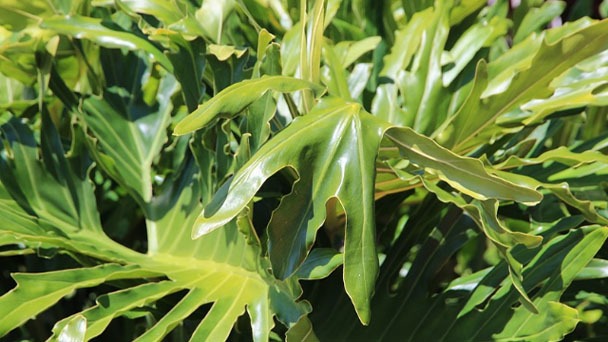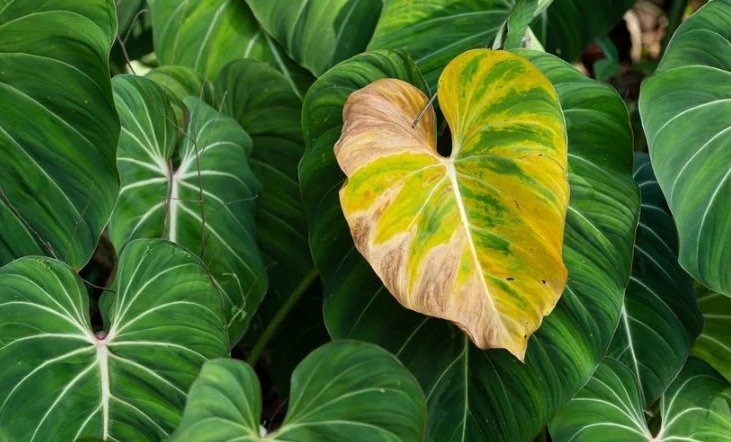Why Are My Philodendron Leaves Turning Yellow - How to Solve It
Written by Ivy
Dec 16 2022

Plant aging, overwatering or underwatering, incorrect lighting, low humidity, and other factors are the main causes of Philodendron leaves turning yellow. Today, we'll pay particular attention to yellowing Philodendron leaves and solutions.
Why Are My Philodendron's Leaves Turning Yellow?
Philodendrons are so attractive and colorful. They are a well-liked low-maintenance houseplant variety that frequently have variegated foliage and can grow in stunningly long cascades. But despite their laid-back demeanor, they can still display yellowing foliage, which is troublesome (in reality, all plants can!). Continue reading to find out why your Philodendron's foliage may be yellowing and our quick fixes to get it back on track!
Aging
Most plants occasionally display some yellowing of their foliage, as you'll discover. They do this to focus on pushing out new leaves, and occasionally, particularly young new leaves simply do not thrive. This is simply typical plant behavior, not the result of a systemic health problem. If your Philodendron is receiving the proper care and is generally looking healthy, but some of its leaves are yellow, you can simply pull them off or trim them off with a pair of clean, sharp scissors or shears.
The Fix
Breathe deeply and wait patiently for your beloved split-leaf philodendron to complete its normal leaf-drop phase. A good rule of thumb from our experts is: "if it's still green, it's still alive." Your plant will start growing new, healthy, green leaves as soon as the old ones have shed. Once the decayed foliage is shed, it might grow even more quickly!
Overwatering Or Underwatering
Yellowing foliage is one of the most obvious signs that philodendrons have been overwatered, a problem that can occur. Instead of watering these plants on a schedule, water them only when the top two inches of soil feel dry to the touch. Lift up some of the decorative moss on your plant and insert your finger two inches into the soil to measure the moisture levels. You should water the plant if the soil is dry. Hold off, though, if it's still wet!
The Fix
It's not difficult to tell if your philodendron has been overwatered or underwatered.
Underwatered Split-Leaf Philodendron
Warning Sign: The soil is dry, and your plant's leaves are shriveled.
- Saturate your plant with water, preferably by watering from the drainage tray or placing the plant in your kitchen sink, filled with 2 inches of water
- Allow excess water to drain completely
Overwatered Split-Leaf Philodendron
Warning Sign: When you overwater your plant, the soil becomes soggy and the leaves turn yellow (moderate overwatering) or brown and mushy (severe overwatering).
- For mild to moderate overwaterings, simply leave your plant alone and allow excess moisture to evaporate from the soil
- Replace the soil in the split-leaf philodendron's pot if there have been moderate to severe overwaterings. Before transplanting your philodendron, make sure there are no signs of root rot and remove any decaying, wet roots.
- In the future, only water when the soil is dry to 2-inches

Incorrect Light
Everyone is aware that when exposed to the sun all day, they should drink more water, and the same is true for their plants. Your philodendron will use up the water in its soil more quickly the more light it receives. So, during the sunnier, warmer months of the year, check its moisture levels frequently and make adjustments as necessary.
The overall health and foliage of your philodendron will suffer if it receives too much light. Keep in mind that philodendrons cannot tolerate direct, bright sunlight because it will sunburn their leaves, a symptom that manifests as discoloration and occasionally as yellowing.
The Fix
Your philodendron needs more bright light if the leaves are yellow and the leaf tips are crispy. Bring it nearer to a window, but not too close that it is in direct sunlight all day. If it has burned spots, move it farther away or cover it with a sheer curtain in the window.
If your room doesn't have enough natural light or if the light in your area changes significantly throughout the year, you can also use an indoor grow light to regulate the amount of light your philodendron receives. To determine where your philly grows best, don't be afraid to experiment with different pot placements.
A Lack of Humidity
Philodendrons may experience humidity problems in regions that are particularly dry. It is beneficial to increase your Philodendron's humidity by misting it a few times per week if your home is typically dry or if a heater or air conditioner is frequently on.
The Fix
Try misting your split-leaf philodendron's leaves once or twice per day if you think low humidity is making your plant suffer. Invest in a room humidifier to increase the air's moisture content if the extra moisture makes the leaves chirpy so you won't have to mist as much.
Pests
Indoor plants frequently suffer from insect and other pest infestations, and the split-leaf philodendron is no exception. Common pests can eat your plants, sucking the moisture out of their leaves and turning them yellow. These pests include aphids, spider mites, mealybugs, and scale.
Look for yellowing around the edges of the affected leaves and spots where the bugs may have nibbled if you suspect your plant is being attacked by pests. If you lightly mist spider mites with water, you can see the nearly invisible webs they are weaving.
The Fix
Different pests necessitate different treatments because they can harm your plant in a variety of ways that aren't always obvious. You can successfully avoid infestations and get rid of minor pest issues naturally by misting your plant with a weak solution of white vinegar and water. The soil of the plant can also be protected from hungry insects by incorporating a teaspoon of neem oil into a gallon of water.
Root Rot
In split-leaf philodendrons, severe or persistent overwatering can cause a condition known as Pythium root rot. If left untreated, this fungus can stunt your plant's growth, make its leaves wilt, and even kill your plant. Your philodendron's leaves will turn yellow and then brown if it is on the verge of dying from root rot, but they won't drop off the plant as they do during seasonal shedding.
Dig up a little dirt to reveal your plant's roots so you can be certain root rot is the source of its suffering. If they're brown or black, mushy, or tender and "peely", you've got a case of root rot on your hands.
The Fix
If root rot is discovered early enough, it can be fixed! By digging it up and getting rid of the soil, you can try to save your philodendron. Trim any brown, black, or mushy roots after giving them a fresh water rinse. To avoid further harm, repotter your plant in new, drained soil.
Poor Soil Nutrition
Philodendron leaves turning yellow may be caused by chlorosis, which causes yellowing leaves. This condition results from a lack of nutrients in the soil. Your philodendron's leaves will develop v-shaped yellow patterns along the veins if chlorosis is the cause.
The Fix
Add a teaspoon of Epsom salts (magnesium sulfate) to a gallon of water to increase the magnesium content of your soil. With this supplement, avoid making a big splash! Don't saturate the soil with water; only use what is necessary. The soil may be low in iron if the yellowing persists. With a commercial fertilizer like Ironite, you can make up for a soil's lack of iron.
Final Thoughts on Philodendron Yellow Leaves
Philodendron cultivation will inevitably result in yellow leaves. Yellow foliage is frequently a normal part of the growth process. The leaves are now dying off so that new ones can take their place because they have completed their task.
Don't freak out if you notice that the foliage on your philodendron is more yellow than usual. I advise checking again for leaf spot disease symptoms before using the method of exclusion to identify potential environmental causes.
Your philodendron should quickly return to its lush, green self with a well-designed care regimen and some pruning!
FAQs
Will Yellow Philodendron Leaves Turn Back Green?
No, the plant tends to ignore a leaf once it loses its chlorophyll, which causes it to wither and die. This indicates that the leaves of yellow plants won't change back to green.
Should I Remove Yellow Leaves from Philodendron?
While some people choose to have the dead leaves fall off naturally, others choose to remove them. Aesthetic preference informs this decision. If you wind up with a long strand of vine without leaves, I advise propagating it through cuttings to grow a bushier plant and new baby plants to share or plant in the same pot for a fuller appearance.
Latest Updated
- Benefits of Bugleweed - 7 Science-backed Health Benefits
- Bugleweed Dangers & Side Effects - Is It Poisonous?
- How to Plant Evergreen Trees - What You Should Know
- When to Plant Evergreens - Grow Guide for Evergreen Trees
- 12 Wonderful Evergreen Shrubs for Your Garden
- 12 Popular Evergreen Plants with Pictures for Beginners
- When And How To Prune A Lilac Bush Like a Pro
- How to Grow & Care for Lilac Vine (Hardenbergia Violacea)
- Japanese Lilac Tree (Syringa Reticulata) Care & Propagation Guide
- Shumard Oak Pros and Cons - What to Know
Popular Articles
- Winter maintenance of Antirrhinum Majus
- How to Grow Terminalia Mantaly Tree
- How to Grow and Care for Crossostephium Chinense
- How to grow Antirrhinum Majus in spring
- Peristeria Elata (Dove Orchid) Profile: Info & Care Guide
- Underwatered Snake Plant (Sansevieria Trifasciata) - Signs And How To Fix
- How to Care for Brazilian Jasmine Plant (Mandevilla Sanderi)
- How to Grow & Care for Graptopetalum Purple Delight in Summer
- Rosa Chinensis (China Rose): Plant Growing & Care Tips
- How to Care for Baby Sun Rose (Aptenia Cordifolia)